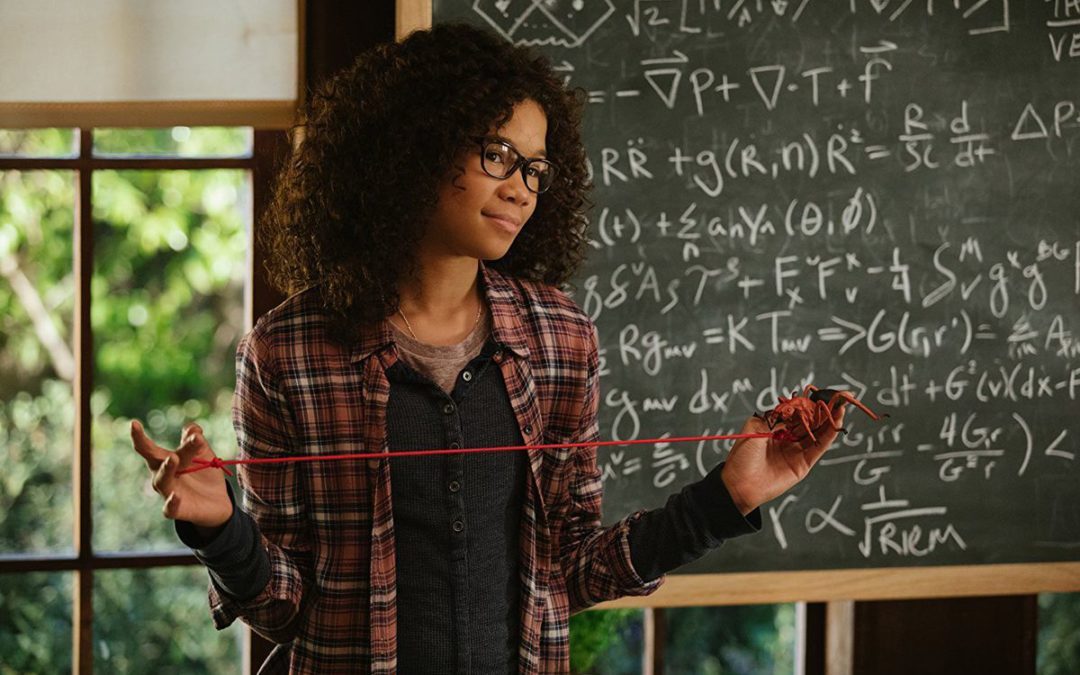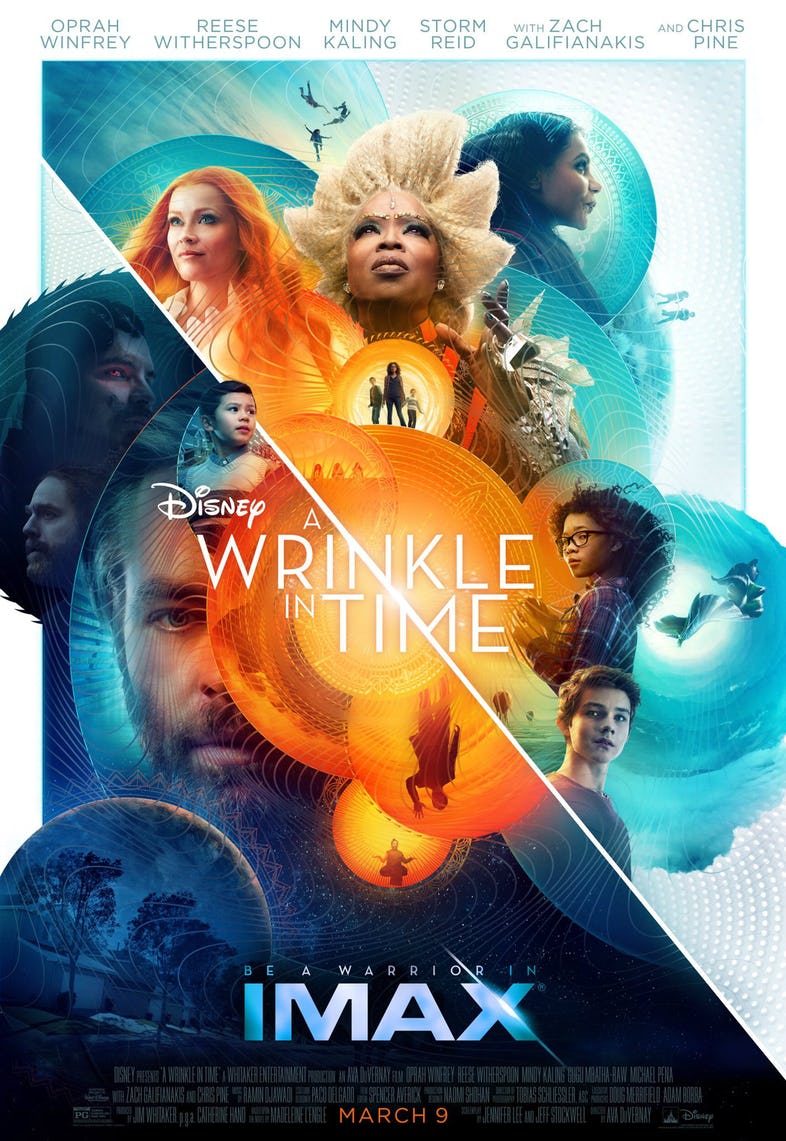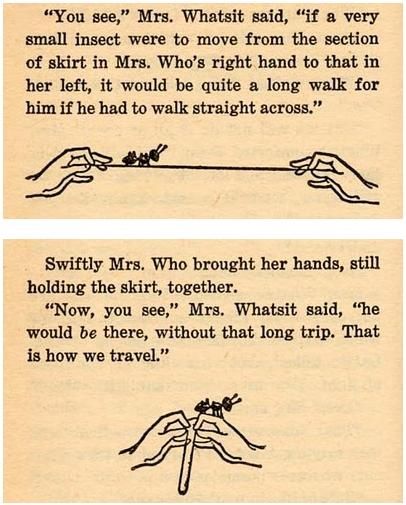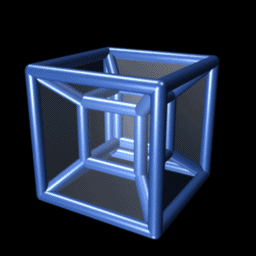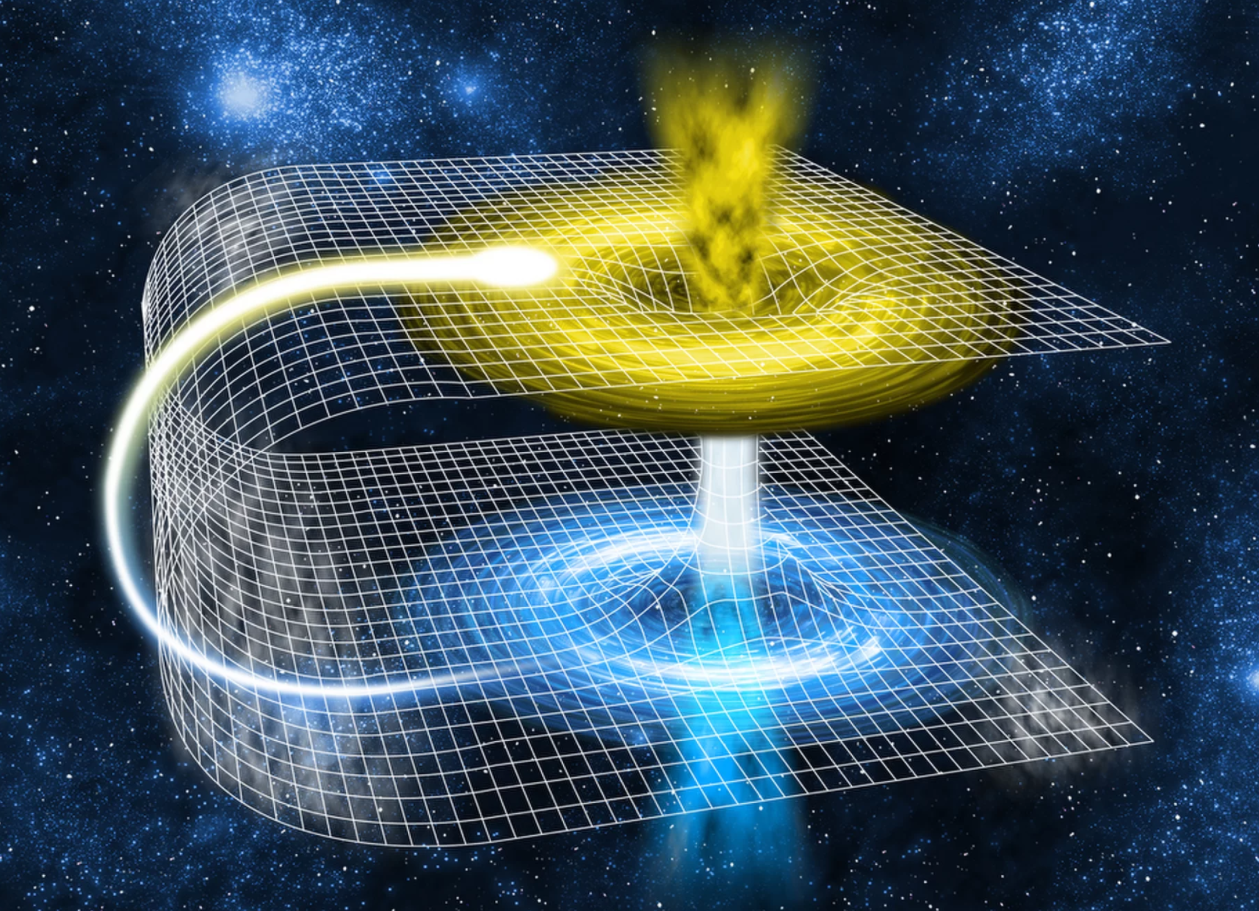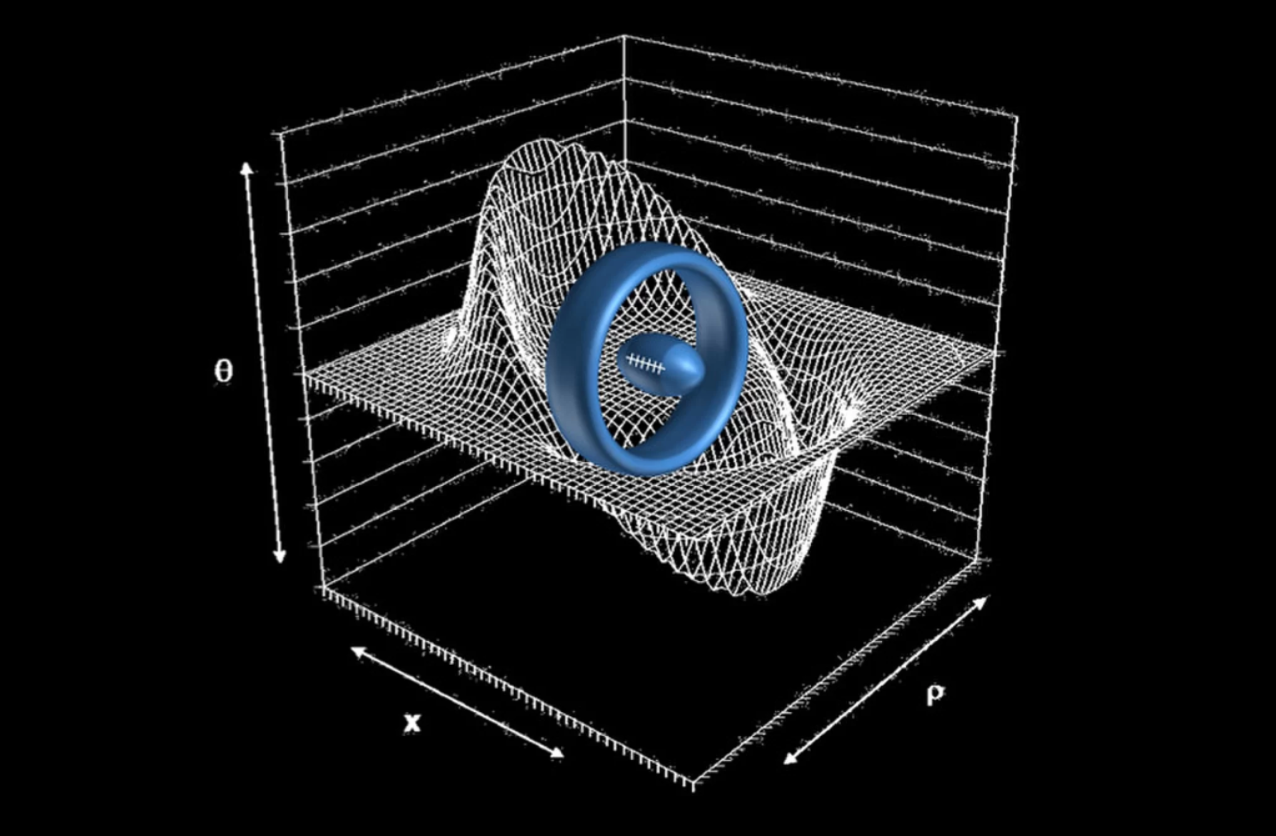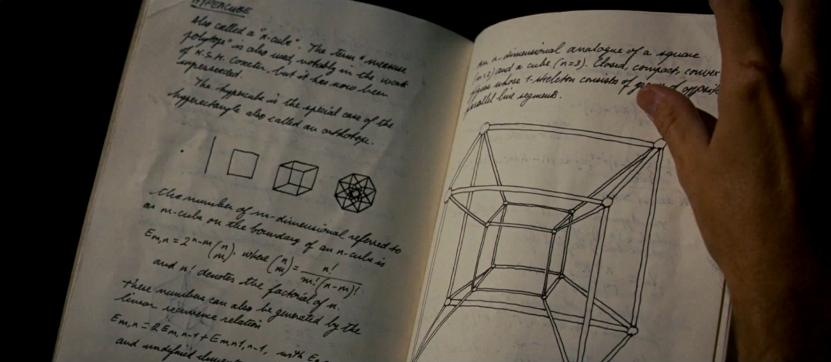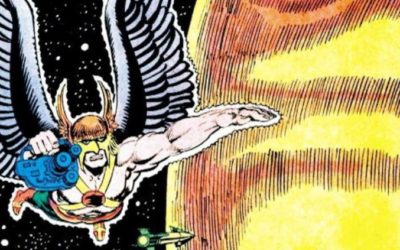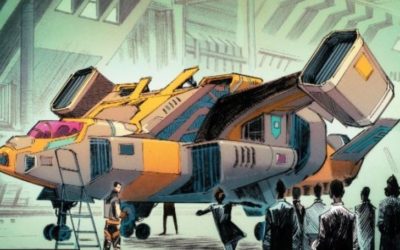Okay, there will be a couple of mild spoilers for Disney’s upcoming version of A Wrinkle in Time in here, but tesseracts are cool.
But let’s be clear on what we’re talking about.
A Wrinkle in Time’s tesseract – the place where many pop culture fans most likely first ran into the word – refers to the fifth dimension, envisioned by author Madeleine L’Engle. With the right knowledge of the fifth dimension (like that acquired by Dr. Alex Murray, played by Chris Pine in the new movie version), individuals can tesser – fold space and time. That’s the “wrinkle” of A Wrinkle in Time.
Personally, I’ll always remember my mother reading the story to my brother and me when we were kids. L’Engle was so enamored with the idea that the original novel included illustrations showing what Mrs. Whatsit was talking about, and I know I’m not alone in saying that the image has stuck with me since I saw it years and years ago:
Or as film version of Mrs. Whatsit puts it in the movie’s trailer, “The fifth dimension’s a tesseract. You add that to the other four dimensions, and you can travel through space without having to go the long way around. In other words, to put into Euclid, or old-fashioned plane geometry, a straight line is not the shortest distance between two points.”
The concept feels similar to a wormhole or a warp jump of science fiction, but it’s not exactly either. It’s something subtly different, and it’s a mechanism for travel. Tessering it what gets Dr. Murray to the failed utopia of Camazotz – which, of course, starts the whole rescue mission, led by his daughter Meg, played by Storm Reid.
L’Engle’s inspiration for tesseracts and “wrinkling” time (or wrinkle in space-time) does have deep physics roots though, she was hooked on Albert Einstein’s ideas of non-linear time, general and special relativity and greater cosmology.
But the word wasn’t hers, and she didn’t make it for her story.
Okay. So What’s a Tesseract, Really?
Don’t get me wrong – the terminology and use of the word by L’Engle is great, and while there’s evidence to suggest she while knew the real-world explanation of a tesseract was and maybe meant for its characteristic structure to play a role in the story, the tesseracts of our world have little to do with crossing the universe.
The word “tesseract” is attributed to scientist and science-fiction writer Charles Howard Hinton, who in 1880 – while trying to help his readers envision the fourth dimension, came up with the classic visual of a cube within a cube. Hinton tried several terms to describe the cube-within-a-cube concept, and settled on tesseract in 1888 for his book, A New Era of Thought.
In our world, a tesseract is also known as a hypercube – the cube within a cube. But it’s not a cube within a cube. It’s as related to a three-dimensional cube as a three-dimensional cube is related to a square. Also called an 8-cell, a classical (non-L’Engle) tesseract can be unfolded into eight cubes. To visualize that – well, just look at the groovy gif, or try to envision a cube whose six sides are three-dimensional cubes, rather than squares, and you’re part way there.
Okay – think of it, and the progression of dimensions that gets to a tesseract like Neil deGrasse Tyson says below – a point has zero dimensions, a line one dimension (length, x), a square two dimensions (length and width, x and y), and a cube three dimensions, length width and height (x, y, and z).
Good with me so far? Now – two points define a line, or in dimension-speak, a thing with one dimension is defined by two things with no dimensions. A square’s two dimensions is built from the one dimensions of lines, and a cube’s three dimensions are defined by the two dimensions of six two-dimensional squares.
A tesseract, or a four-dimensional (w, x, y and z) shape is defined by three dimensional cubes. Visually, as we experience it, a tesseract looks like a projection of a cube within a cube. It’s like one of those soap bubble creations some people can make with straws and a lot of pateience.
But the thing is this – projecting the image of anything above two dimensions cuts off a dimension. Shine a light on a transparent three-dimensional cube, and you get a two dimensional image that we’ve all drawn on notebooks when you’re bored. A three-dimensional model of a hypercube – not entirely difficult to make – is a projection of a four- dimensional tesseract. The act of “shining a light” on a four dimensional object results in a three dimensional projection that we can hold in our hands.
https://youtu.be/d-68SwgVrhs
This all may sound really, really weird, but geometrically, and to physicists who study the dimensions of reality (most likely 10, maybe 11), it’s so much more. But our visualization of it is not that terrific because we can’t see or experience the fourth dimension. We’re just not set up for it, and can only visualize three dimensions that are perpendicular to each other. A fourth dimension? Always hidden to our sense, but not to our math.
Tesseracts are a gateway to thinking about the higher dimensions of the cosmos, which is a gateway to thinking about string theory which is a possible way to unify the quantum mechanics of the very, very small with gravity. String theory, by its nature, would require extra dimensions of space past our well-investigated three.
Thinking along these lines can get pretty freaky, even to physicists who think about this kind of stuff all the time. For example, Carl Sagan, from the original Cosmos miniseries, which starts with a nod to Edwin A. Abbot’s classic Flatland.
Lisa Randall:
And Brian Greene:
So Tesseracts Aren’t Related to Space at All?
Didn’t say that. Did not say that.
As just mentioned, tesseracts are the gateway to thinking about more than three dimensions, and that involves the whole of the universe and everything in it. And those higher dimensions most likely inform string theory, the leading candidate to explain how things are, so in the end, tesseracts may play a hugely important role in cosmology, or someday, in how cosmology is taught to middle schoolers.
But as for a tesseract being a means of transportation across or within the universe? Nope. For now, that’s not what tesseracts in our world are about.
Now the function of a tesseract, though – getting people from one part of the universe to a spot far away almost instantaneously, those roles are played by a couple of actors: wormholes and warp drives.
Wormholes probably are the best fit for what L’Engle was trying to accomplish with her tesseract. Still completely theoretical (but well known to pop culture fans, from Justice League’s Boom Tubes to Star Trek: Deep Space Nine’s wormhole, the film Contact and more), wormholes are not just allowed, but predicted by Einstein’s theory of general relativity. Theorized to exist in the early part of the 20th century, the concept was formally assembled by Einstein and Nathan Rosen in 1935, but they called them “bridges,” or as they’re known to cosmologists and physicists who study them, “Einstein-Rosen bridges.”
Where have you heard that term before? The first Thor movie, maybe? When Marvel Studios asked USC physicist Sean Carroll for some science help on the film, one of his suggestions was that rather than magic, the Rainbow Bridge transported Asgardians to their varied destinations via Einstein-Rosen bridges. The rune-looking “scar” left in the ground is a “signature” of the energy required to open and close the wormholes. This all fits with creators Stan Lee and Jack Kirby’s vision of Thor and Asgard in the Marvel Universe – highly, highly advanced aliens that can manipulate time and space with technology so advanced that to us, it looks like magic.
The downside of wormholes and their (possible over-) use in science fiction and pop culture is that no one reads the asterisk by the description. While general relativity predicts wormholes should exist, it also predicts some serious drawbacks:
- They’re microscopic. They would start out around 1 x 10-33 centimeters. They may expand though.
- They’re inherently unstable – and to keep them open and stable, you’d need something equally weird, called exotic matter. Exotic matter is its own bag of crazy, but a couple of its characteristics include negative energy density and negative pressure. Getting any exotic matter in appreciable quantities isn’t even remotely close to an option, if we ever did find a wormhole.
- Radiation blasts. While they’re suggested to exist, we don’t know everything about wormholes, but it’s pretty safe to say that since these things mess with the very basics of spacetime, the energy surrounding them will be nuts. In terms of cosmology and the universe, that often means one thing: radiation. Lots of it.
- And more – Aiming a wormhole? Traveling through – matter moving through this hole in space time? Would the voyagers through a wormhole be traveling through just space or space and time?
There’s a lot to be done when it comes to wormholes, first and foremost would be actually finding one, or finding the evidence of one.
Warp drives, on the other hand are a little “realer” and map more directly to L’Engle’s tesseract. The basic idea of of warp drive lies in its name: warp. While Star Trek and other science fiction have used the term “warp drive” with abandon over the decades, a real concept for a warp drive is pretty specific: you’d have to warp space.
Warp travel took a step out of science fiction in 1994 when Mexican physicist Miguel Alcubierre suggested how it might work. Again, exotic matter is involved, this time, in a ring around a craft. This ring would cause space to contract in front of it (like the hem of Mrs. Whatsit’s dress) and expand behind it, while the starship itself stayed in a bubble of “regular” spacetime.
Through this method, the ship would be able to travel about 10 times faster than the speed of light – but don’t worry, no laws would be broken. Sure, nothing can move faster than the speed of light, but nothing is. The space between the start point and end point is just being contracted.
While this pretty much captures the essence of L’Engle’s tessering, the downside is that everything costs something. In the case of the Alcubierre Drive, you’d have to pay in energy. Original calculations showed that to contract spacetime in front of the ship, you’d need the energy-mass equivalent of Jupiter. More recent calculations have scaled that waaaay back, but still – it’s requiring materials and technology that, right now, are as good as magic to us.
But maybe someday.
I Didn’t Know There Was a Tesseract in A Wrinkle in Time. So Why Have I Heard the Word Before?
Maybe a little movie called Marvel’s The Avengers? Yeah – that’s where it made a huge impact on the cultural lexicon, but the build-up for it started with Iron Man 2 in 2010 where the image of a tesseract was seen briefly in Howard Stark’s journals. The actual tesseract was spotted in the post-credits scene of Thor, and of course, it played a key role in Captain America: The First Avenger, where it was the prize the Red Skull sought. Recall that while it went down (along with Captain America) it was Howard Stark who recovered it…and drew a picture of it in his journal, mentioned earlier.
Marvel’s tesseract is a able to do what the plot calls for it to do, essentially, and so far, that’s included create energy (presumably nuclear) and transport people – maybe following a line from L’Engle’s use of the idea. As we’ve learned since, the tesseract was a holder for the Space Stone, one of the six Infinity Stones that Thanos is after, and presumably gets in April’s Avengers: Infinity War.
Where else? Remember Interstellar? Towards the end of the film, Matthew McConnell’s character, Cooper fell into the black hole, Gargantua. Instead of finding himself spaghettified, found himself inside a hypercube-style setting, with angles and funky projections and extensions. The tesseract he found himself in was the way the bulk beings of the far future – which could perceive five dimensions – were able to communicate anywhere and anywhen through the manipulation of gravity.
Much more often, the term “tesseract” is a stand-in for something that doesn’t follow our rules for dimensionality – think “it’s bigger on the inside!” and you get the idea of what tesseracts have come to stand for in modern pop culture. Although, to be clear, hypercubes were used in Doctor Who, but not in regards to the TARDIS. Tesseracts, or hypercubes were used by Time Lords to store their thoughts, which could then be sent through time and space, again, perhaps a nod to L’Engle.
So…Tesseracts…What Are They Good For?
Yeah – tesseracts. Why I love tesseracts, and where they come up in my class, is as I said earlier, is due to the fact that they’re gateways.
Figurative. I’m not Loki.
Think back to that moment in elementary school when you either were taught, or learned how to draw a two-dimensional representation of a three-dimensional cube. Try to put yourself back into that headspace, and remember how that perhaps kind of blew your mind? Tesseracts have the same effect on high school physics students, especially when they learn that the three-dimensional model that they’re holding it a “shadow” of a four-dimensional construct that we humans can’t visualize. It blows their minds and opens an entirely new horizon to them, part of the universe that they never knew even existed. They’re something cool that’s just at the edge of their (and everyone’s) understanding…there’s nothing better than something that’s cool and just at the edge of a mystery to pull you in further.
That’s worth the price of admission, right there.
So what are you waiting for? Dig into tesseracts – the adventure awaits.


